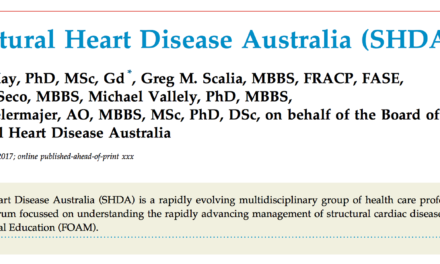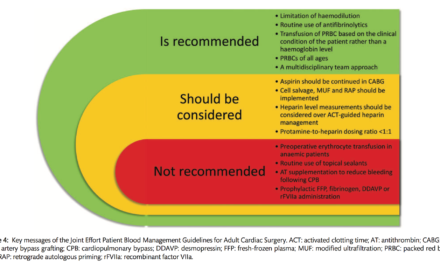Welcome to the monthly SHDA Research Update. Our specialists have selected 3 seminal papers that have been recently published in each speciality.
Quick Links
Perioperative Medicine
Summarised by Sarah Catchpoole
An excellent editorial regarding the different methods of measuring cardiac output. While the ‘gold standard’ is echocardiography, true cardiac output is unknown, and therefore evaluating accuracy can only be done by comparison to the reference method, which may or may not be accurate. Therefore, the degree of ‘agreement’ between the new device and the standard device can reflect errors in both. The editorial discusses in some detail the limit of acceptable agreement and also gives consideration to the impact of inevitable missing data.
A case report of an 82 year old man with aortic stenosis undergoing TAVI. While initial valve placement was satisfactory, continuous TEE showed progressive paravalvular leakage followed by embolization of the valve, migration into the LV, inversion and complete obstruction of the left ventricular outflow tract. The procedure was successfully converted to an on-pump surgical replacement and cardiac output was restored. The patient recovered fully. This case illustrates the value of extended TEE monitoring, balanced against the additional risks of general anaesthesia.
Cardiac Imaging
Summarised by Sarah Catchpoole
A brief case study demonstrating excellent visualisation using CT and curved planar reformation imaging of occluded distal branches in a chronic total occulusion in the right pulmonary artery. Subsequent balloon pulmonary angioplasty revascularised two of the three occluded braches successfully.
This paper describes and evaluates a systematic measurement methodology using multi-slice CT for structures of the mitral valvular complex prior to TMVR. Two independent observers completed a retrospective analysis of 49 scans. The inter-observer difference was below 10% and intra-class correlation above 0.81 for key geometrical metrics. Therefore, multi-slice CT can provide measurements that are important for patient selection and sizing of TMVR devices.
Unlu et al. noted a pattern of ‘apical traction’ (systolic movement of the RV apex towards the LV, caused by traction from the LV) in patients with pulmonary hypertension. In a retrospective echocardiographic analysis of 62 patients with pre-capillary pulmonary hypertension, apical traction was observed in 31 patients. While there was no difference in LV function, these patients had worse functional parameters and higher systolic pulmonary arterial pressure. Apical traction was also an independent predictor of death or heart/lung transplantation (p = 0.015).
Cardiology
Summarised by Sarah Catchpoole
The ACC and AHA guidelines differ with respect to the recommended threshold of aortic root or ascending aortic dilatation justifying surgical intervention for patients with bicuspid aortic valves. This combined statement of clarification from the two guideline writing committees provides updated recommendations after review of the evidence.
Levine RA et al. Mitral valve disease-morphology and mechanisms. Nat Rev Cardiol. 2015 Oct 20
A comprehensive review of the mitral valve and its pathologies, including development, structure, ageing, degenerative, hypertrophic and genetic disorders. Special emphasis is placed on the dynamic nature of the mitral valve throughout life and potential capacity to reactivate early growth processes, with consideration of current areas of investigation and future novel therapeutics.
A case study of a 36 year old woman presenting with cough and progressive dyspnoea, on a background of idiopathic fibrosing mediastinitis with asymptomatic superior vena cava obstruction. Echocardiography demonstrated pulmonary hypertension and left upper and left lower pulmonary vein stenosis. Bare metal stents were successfully implanted in the two veins, significantly decreasing Doppler velocities with immediate marked symptomatic improvement for the patient.
Cardiothoracic Surgery
Summarised by Andrew Haymet
In this study, all patients who had undergone AVR in Sweden with bioprosthetic or mechanical valves between 1997 and 2013 were identified to evaluate long term all-cause mortality. Of the 4545 patients, 60% (2713/4545) had received mechanical valves and 40% (1832) had received bioprostheses. In 1099 propensity-matched pairs followed up over a mean of 6.6 years, 16% (180/1099) had died in the mechanical valve group and 20% (217/1099) had died in the bioprosthetic group. Survival was higher in the mechanical group with 5, 10 and 15-year survival of 92, 79 and 59% vs 89, 75 and 50% (hazard ratio 1.34; 95% CI 1.09-1.66); p=0.006).
Surgical sutureless aortic valves may shorten procedure times and improve outcomes for high risk patients. The early clinical and echocardiographic performances of the Enable sutureless valve were evaluated in 63 patients who underwent implantation of the valve between August 2012 and October 2014. Implant success was 100% with 30-day mortality of 1.6% (1/63), and late mortality was 3.2% (2/62). No mortality was valve related. Intraoperative need for revision was 6.3% (4/63). At latest follow up (mean 10+/-8 months), 61 patients were NYHA Class I, without any patients developing moderate or severe regurgitation in the postoperative period.
Physiological ‘windkessel’ recoil of the aorta may be diminished by prosthetic replacement of the thoracic aorta with Dacron grafts. Aortic valve function may also be affected in valve sparing procedures. A novel elastic graft prosthesis was tested in a mock circulation loop in a series of 21 fresh porcine aortas, and its haemodynamics were compared before and after replacement. Whilst the novel prosthesis could not match the distensibility of the native aorta, it did preserve some ‘windkessel’ function. Maximum time-pressure differential dp/dt increased by 13% with unchanged wall tension of the residual aorta.
Valve repair for ischaemic mitral regurgitation (IMR) is associated with high IMR recurrence rates when undersized annuloplasty rings are employed. A novel valve-modelling algorithm combined with pre-repair 3D echocardiography was tested to determine the likelihood of IMR recurrence six months post repair. Intraoperative real time TOE was performed in 50 patients undergoing undersized ring annuloplasty for IMR and in 21 patients with normal mitral valves. This protocol was found to be predictive of recurrent IMR. In particular, preoperative regional leaflet tethering of segment P3 was found to be a strong independent predictor of IMR recurrence after undersized ring annuloplasty.


















